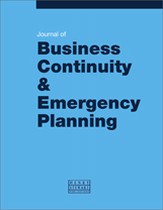The UK water crisis: What actions the government and private sector need to take
Abstract
The paper discusses why resilience is increasingly important for companies to measure and address, thinking about relevant issues such as climate change and extreme weather. It gives insight on how companies measure their resilience and that it is more than a business continuity issue; indeed, it is a board issue. The paper looks at the role of regulation for companies with national critical infrastructure in putting in resilience guidelines and discusses the benefits of regulation in resilience, presenting a case study of the UK Water Services Regulation Authority resilience guidelines.
The full article is available to subscribers to the journal.
Author's Biography
Emmeline Skelton is a member of PwC’s Performance Assurance Practice and works with clients across the UK on sustainability and resilience related projects. Her clients include companies running National Critical Infrastructure. She has a particular interest in disaster risk reduction, contributing to the United Nations’ continuing efforts to support the world’s most vulnerable communities, by participating in their Geneva conference on this topic. This led to an opportunity to become one of the PwC representatives at the National Dialogue for the Hyogo Framework for Action. Emmeline developed a resilience benchmarking tool for PwC, which led to her being shortlisted for an innovation award as part of the European BCI Awards 2013. She also successfully nominated the Risk Assurance Enterprise Resilience proposition as a PwC Global Innovation Spotlight, securing funding to promote it and encouraging its rollout across the PwC global network. Emmeline has also guest authored a chapter in Incisive Media’s latest book, which focuses on resilience.
Citation
Skelton, Emmeline (2015, March 1). The UK water crisis: What actions the government and private sector need to take. In the Journal of Business Continuity & Emergency Planning, Volume 8, Issue 4. https://doi.org/10.69554/YYXE7426.Publications LLP
